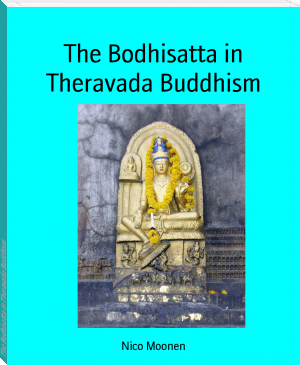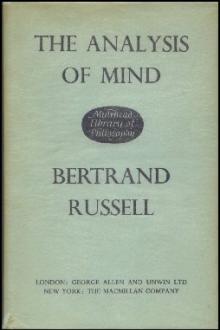Buddhism and Buddhists in China by Lewis Hodous (best way to read e books .TXT) 📕

But such mandates were as unsuccessful as other similar schemes havebeen. In the third century A. D. after the Han dynasty had ended, Chinawas broken up into several small kingdoms which contended for supremacy,so that for about four hundred years the whole country was in a state ofdisunion. One of the strong dynasties of this period, the Northern Wei(386-535 A. D.), was distinctly loyal to Buddhism. During itscontinuance Buddhism prospered greatly. Although Chinese wer
Read free book «Buddhism and Buddhists in China by Lewis Hodous (best way to read e books .TXT) 📕» - read online or download for free at americanlibrarybooks.com
- Author: Lewis Hodous
- Performer: -
Read book online «Buddhism and Buddhists in China by Lewis Hodous (best way to read e books .TXT) 📕». Author - Lewis Hodous
The emperor alone worshipped the supreme deity, Shang Ti; the great officers of state, according to the dignity of their office, were related to subordinate gods and required to show them adequate respect and reverence. Confucius and a long line of noted men following him were semi-deified [Footnote: Confucius was by imperial decree deified in 1908.] and highly reverenced by the literati, the class from which the officers of state were as a rule obtained, in connection with their duties, and as an expression of their ideals. To the common people were left the ordinary local deities, while all classes, of course, each in its own fashion reverenced, cherished and obeyed their ancestors. It should be remarked at this point that Confucianism of this official character has broken down, not only under the impact of modern ideas, but under the longing of the Chinese for a universal deity. The people turn to Heaven and to the Pearly Emperor, the popular counterpart of Shang Ti.
Viewed from another angle, Confucianism is an elaborate system of ethics. In writings which are virtually the scriptures of the Chinese people Confucius and his successors have set forth the principles which should govern the life of a people who recognize this spiritual universe and system. These ethics have grown out of a long and, in some respects, a sound experience. Much can be said in their favor. The essential weaknesses of the Confucian system of ethics lie in its sectional and personal loyalties and its monarchical basis. The spirit of democracy is a deadly foe to Confucianism. Another element of weakness is its excessive dependence upon the past. Confucius reached ultimate wisdom by the study of the best that had been attained before his day. He looked backward rather than forward. Consequently a modern, broadly educated Confucianist finds himself in an anomalous position. He does not need absolutely to reject the wisdom which Confucianism embodies, but he can no longer accept it as a sound, reliable and indisputable scheme of thought and action. Yet its simple ethical principles and its social relationships are basal in the lives of the vast masses of the Chinese.
5. Buddhism an. Inclusive Religion.
Upon this, confused jumble of spiritism, superstition, loyalty to ancestors and submission to a divine hierarchy Buddhism was superimposed. It quickly dominated all because of its superior excellence. The form of Buddhism which became established in China was not, to be sure, like the Buddhism preached by Gautama and his disciples, or like that form of Buddhism which had taken root in Burma or Ceylon. Except in name, the Buddhism of Southern Asia and the Buddhism which developed in China were virtually two distinct types of religion. The Buddhism of Burma and Ceylon was of the conservative H�nay�na (“Little Vehicle” of salvation) school, while that of China was of the progressive Mah�y�na (“Great Vehicle” of salvation) school. Their differences are so marked as to be worthy of a careful statement.
The Hinayana, which is today the type of Buddhism in Ceylon, Burma and Siam, has always clung closely to tradition as expressed in the original Buddhist scriptures. Its basic ideas were that life is on the whole a time of suffering, that the cause of this sorrow is desire or ignorance, and that there is a possible deliverance from it. This deliverance or salvation is to be attained by following the eightfold path, namely, right knowledge, aspiration, speech, conduct, means of livelihood, endeavor, mindfulness and meditation. To the beatific state to be ultimately attained Gautama gave the name Nirvana, explained by his followers variously either as an utter extinction of personality or as a passionless peace, a general state of well-being free from all evil desire or clinging to life and released from the chain of transmigration. Hinayana Buddhism appeals to the individual as affording a way of escape from evil desire and its consequences by acquiring knowledge, by constant discipline, and by a devotedness of the life to religious ends through membership in the monastic order which Buddha established. It encourages, however, a personal salvation worked out by the individual alone.
The Mah�y�na school of Buddhists accept the general ideas of the Hinayana regarding life and salvation, but so change the spirit and objectives as to make Buddhism into what is virtually another religion. It does not confine salvation to the few who can retire from the world and give themselves wholly to good works, but opens Buddhahood to all. The “saint” of Hinayana Buddhism is the arhat who is intent on saving himself. The saint of Mah�y�na Buddhism is the candidate for Buddhahood (Bodhisattva) who defers his entrance into the bliss of deliverance in order to save others. Mah�y�na Buddhism is progressive. It encourages missionary enterprise and was a secret of the remarkable spread of Buddhism over Asia. Moreover, while the H�nay�na school recognizes no god or being to whom worship is given, the Mah�yan� came to regard Gautama himself as a god and salvation as life in a heavenly world of pure souls. Thus the Mah�y�na type of thinking constitutes a bridge between H�nay�na Buddhism and Christianity. In fact, a recent writer has declared that H�nay�na Buddhists are verging toward these more spiritual conceptions. [Footnote: See Saunders, Buddhism and Buddhists in Southern Asia, pp. 10, 20.]
After the death of S�kyamuni [Footnote: S�kyamuni is the name by which Gautama, the Buddha, is familiarly known in China.] Buddhism broke up into a number of sects usually said to be eighteen in number. When Buddhism came to China some of these sects were introduced, but they assumed new forms in their Chinese environment. Besides the sects brought, from India the Chinese developed several strong sects of their own. Usually they speak of ten sects although the number is far larger, if the various subdivisions are included.
To indicate the manifold differences between these groups in Buddhism would take us far afield and would not be profitable. It will be of interest, however, to consider some of the chief sects. One of the sects introduced from India is the Pure Land or the Ching T’u which holds before the believer the “Western Paradise” gained through faith in Amit�bha. Any one, no matter what his life may have been, may enter the Western Paradise by repeating the name of Amit�bha. This sect is widespread in China. In Japan there are two branches of it known as the Nishi-Hongwanji and the Higashi-Hongwanji with their head monasteries in Kyoto. They are the most progressive sects in Japan and are carrying on missionary work in China, the Hawaiian Islands and in the United States.
Another strong sect is the Meditative sect or the Ch’an Men (Zen in Japan). This was introduced by Bodhidharma, or Tamo, who arrived in the capital of China in the year 520 A.D. On his arrival the emperor Wu Ti tried to impress the sage with his greatness saying: “We have built temples, multiplied the Scriptures, encouraged many to join the Order: is not there much merit in all this?” “None,” was the blunt reply. “But what say the holy books? Do they not promise rewards for such deeds?” “There is nothing holy.” “But you, yourself, are you not one of the holy ones?” “I don’t know.” “Who are you?” “I don’t know.” Thus introduced, the great man proceeded to open his missionary-labors by sitting down opposite a wall arid gazing at it for the next nine years. From this he has been called the “wall-gazer.” He and his successors promulgated the doctrine that neither the scriptures, the ritual nor the organization, in fact nothing outward had any value in the attainment of enlightenment. They held that the heart of the universe is Buddha and that apart from the heart or the thought all is unreal. They thought themselves back into the universal Buddha and then found the Buddha heart in all nature. Thus they awakened the spirit which permeated nature, art and literature and made the whole world kin with the spirit of the Buddha.
“The golden light upon the sunkist peaks, The water murmuring in the pebbly creeks, Are Buddha. In the stillness, hark, he speaks!”
[Footnote: K. J. Saunders in Epochs of Buddhist History.]
Such pantheism and quietism often lead to a confusion in moral relations, but these mystics were quite correct in their morals because they checked up their mysticism with the moral system of the Buddha.
Still another important sect originated in the sixth century A. D. on Chinese soil, namely, the T’ien T’ai (Japanese Tendai), so called because it started in a monastery situated on the beautiful T’ien T’ai mountains south of Ningpo. Chih K’ai, the founder, realized that Buddhism contained a great mass of contradictory teachings and practice, all attributed to the Buddha. He sought for a harmonizing principle and found it in the arbitrary theory that these teachings were given to different people on five different occasions and hence the discrepancies. The practical message of this sect has been that all beings have the Buddha heart and that the Buddha loves all beings, so that all beings may attain salvation, which consists in the full realization of the Buddha heart latent in them.
There was a time when these sects were very active and flourishing in China. At the present time the various tendencies for which they stood have been adopted by Buddhism as a whole and the various sectaries, though still keeping the name of the sect, live peacefully in the same monastery. All the monasteries practice meditation, believe in the paradise of Amit�bha, and are enjoying the ironic calm advocated by the T’ien T’ai. While the struggle among the sects of China has been followed by a calm which resembles stagnation, those in Japan are very active and the reader is referred to the volume of this series on Japanese Buddhism for further treatment of the subject.
When Buddhism entered China it brought with it a new world. It was new practical and new spiritually. It brought a knowledge unknown before regarding the heavenly bodies, regarding nature and regarding medicine, and a practice vastly above the realm of magical arts. In addition to these practical benefits, Buddhism proclaimed a new spiritual universe far more real and extensive than any of which the Chinese had dreamed, and peopled with spiritual beings having characteristics entirely novel. In comparison with this new universe or series of universes which Indian imagination had created, the Chinese universe was wooden and geometric. Since it was an organized system and a greater rather than a different one, the Chinese people





Comments (0)